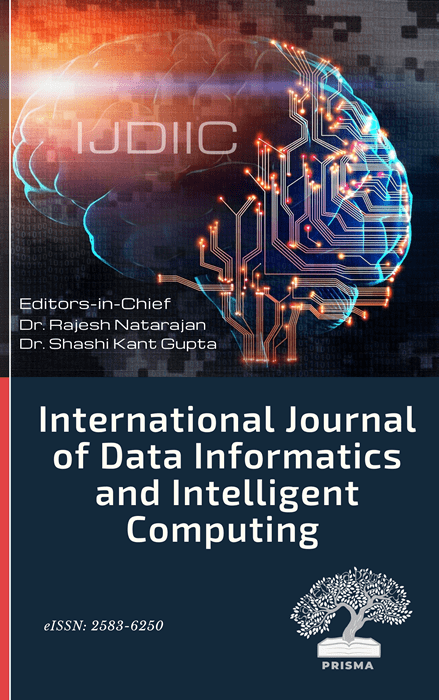Deep Learning based Seasonality and Trend Detection in Sales Forecasting
DOI:
https://doi.org/10.59461/ijdiic.v4i2.170Keywords:
Sales Prediction , Hybrid Deep Learning, Convolutional Neural Networks, Long Short-Term Memory, Time-Series ForecastingAbstract
Sales forecasting is essential for business planning, as it aids inventory management, marketing, and decision-making. Deep Learning combined with time-series analysis boosts prediction accuracy by capturing intricate temporal patterns. Precise sales forecasting remains difficult because of trends, seasonality, and noise. Previous techniques have issues with feature extraction and sequential dependencies, resulting in suboptimal efficiency. This study aims to develop a Hybrid Deep Learning (HDL) technique that combines the benefits of Convolutional Neural Networks (CNNs) and Long Short-Term Memory (LSTM) networks to improve sales prediction accuracy. The primary emphasis is on combining feature extraction and temporal sequence learning to address the shortcomings of conventional methods. The proposed HDL framework prepares a sales dataset for time-series evaluation using a structured workflow that includes data exploration, preprocessing, and aggregation. To better comprehend the fundamental patterns, seasonal decomposition and autocorrelation analyses are used. The sliding window method is used to produce sequential data, which is then split into training and testing sets. Three predictive models—CNN, LSTM, and a hybrid CNN-LSTM—are built and trained using hyperparameter tuning. The models are evaluated using performance metrics such as root mean square error (RMSE), mean absolute error (MAE), and mean absolute percentage error (MAPE). Experimental results demonstrate that the proposed HDL surpasses CNN and LSTM with the lowest RMSE (2171.38), MAE (1219.79), and MAPE (538.18). The HDL technique combines CNN and LSTM to enhance sales prediction accuracy by capturing patterns and seasonality for better demand prediction and business evaluation.
Downloads
References
F. Haselbeck, J. Killinger, K. Menrad, T. Hannus, and D. G. Grimm, “Machine Learning Outperforms Classical Forecasting on Horticultural Sales Predictions,” Mach. Learn. with Appl., vol. 7, p. 100239, Mar. 2022, doi: 10.1016/j.mlwa.2021.100239.
M. Arunkumar, S. Palaniappan, R. Sujithra, and S. VijayPrakash, "Exploring Time Series Analysis Techniques for Sales Forecasting," 2024, pp. 41–55. doi: 10.1007/978-981-99-6755-1_4.
V. Shah and S. Dimitrov, “A comparative study of univariate time-series methods for sales forecasting,” Int. J. Bus. Data Anal., vol. 2, no. 2, p. 187, 2022, doi: 10.1504/IJBDA.2022.126806.
S. Raizada and J. R. Saini, “Comparative Analysis of Supervised Machine Learning Techniques for Sales Forecasting,” Int. J. Adv. Comput. Sci. Appl., vol. 12, no. 11, 2021, doi: 10.14569/IJACSA.2021.0121112.
M. Maslim, E. Ernawati, and K. Arinanda, “Motorcycle Parts Sales Forecasting Using Auto-Regressive Integrated Moving Average Model,” Int. J. Comput. Theory Eng., vol. 12, no. 1, pp. 28–31, 2020, doi: 10.7763/IJCTE.2020.V12.1259.
Preethi Rajan, “Integrating IoT Analytics into Marketing Decision Making: A Smart Data-Driven Approach,” Int. J. Data Informatics Intell. Comput., vol. 3, no. 1, pp. 12–22, Feb. 2024, doi: 10.59461/ijdiic.v3i1.92.
I. G. T. Suryawan, I. K. N. Putra, P. M. Meliana, and I. G. I. Sudipa, “Performance Comparison of ARIMA, LSTM, and Prophet Methods in Sales Forecasting,” sinkron, vol. 8, no. 4, pp. 2410–2421, Oct. 2024, doi: 10.33395/sinkron.v8i4.14057.
Y. Kaneko and K. Yada, “A Deep Learning Approach for the Prediction of Retail Store Sales,” in 2016 IEEE 16th International Conference on Data Mining Workshops (ICDMW), IEEE, Dec. 2016, pp. 531–537. doi: 10.1109/ICDMW.2016.0082.
Ashish Kumar Pandey, “Analysis Role of ML and Big Data Play in Driving Digital Marketing’s Paradigm Shift,” Int. J. Data Informatics Intell. Comput., vol. 2, no. 3, pp. 38–46, Sep. 2023, doi: 10.59461/ijdiic.v2i3.75.
T. Arifin Prasetyo et al., “Sales forecasting of marketing using adaptive response rate single exponential smoothing algorithm,” Indones. J. Electr. Eng. Comput. Sci., vol. 31, no. 1, p. 423, Jul. 2023, doi: 10.11591/ijeecs.v31.i1.pp423-432.
Jun-Ki Hong., "LSTM-based Sales Forecasting Model," KSII Trans. Internet Inf. Syst., vol. 15, no. 4, Apr. 2021, doi: 10.3837/tiis.2021.04.003.
M. Pacella and G. Papadia, “Evaluation of deep learning with long short-term memory networks for time series forecasting in supply chain management,” Procedia CIRP, vol. 99, pp. 604–609, 2021, doi: 10.1016/j.procir.2021.03.081.
A. Schmidt, M. W. U. Kabir, and M. T. Hoque, “Machine Learning Based Restaurant Sales Forecasting,” Mach. Learn. Knowl. Extr., vol. 4, no. 1, pp. 105–130, Jan. 2022, doi: 10.3390/make4010006.
L. Schmid, M. Roidl, A. Kirchheim, and M. Pauly, “Comparing Statistical and Machine Learning Methods for Time Series Forecasting in Data-Driven Logistics—A Simulation Study,” Entropy, vol. 27, no. 1, p. 25, Dec. 2024, doi: 10.3390/e27010025.
B. Lakshmanan, P. S. N. Vivek Raja, and V. Kalathiappan, "Sales Demand Forecasting Using LSTM Network," 2020, pp. 125–132. doi: 10.1007/978-981-15-0199-9_11.
I. Vallés-Pérez, E. Soria-Olivas, M. Martínez-Sober, A. J. Serrano-López, J. Gómez-Sanchís, and F. Mateo, "Approaching sales forecasting using recurrent neural networks and transformers," Expert Syst. Appl., vol. 201, p. 116993, Sep. 2022, doi: 10.1016/j.eswa.2022.116993.
https://www.kaggle.com/datasets/rohitsahoo/sales-forecasting
P. J. Han J, Kamber M, “Data mining: concepts and techniques. 3rd ed,” Amsterdam: Morgan Kaufmann, 2012.
Published
How to Cite
Issue
Section
License
Copyright (c) 2025 Karthikeyan Venkateshwaran

This work is licensed under a Creative Commons Attribution-ShareAlike 4.0 International License.








